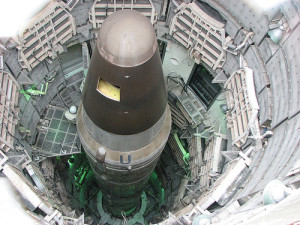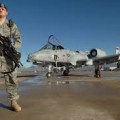 U.S. Nuclear Arsenal Needs Urgent Modernization
U.S. Nuclear Arsenal Needs Urgent Modernization
Frank V. Vernuccio, Jr., J.D.
The recent test launch of an unarmed Minuteman III missile from Vandenberg Air Force Base in California was successful, but concerns about America’s deteriorating nuclear deterrent continue.
Only the U.S., among all the nuclear powers, has allowed its strategic deterrent to deteriorate. Rep. Thornberry (R-Tx,) chair of the House Armed Service Committee) stated that “Our warheads and delivery systems have all been neglected and are aging out at about the same time [that other states are modernizing their nuclear weapons systems.”
 Writing in the Wall Street Journal, retired Vice Admiral and former Defense Nuclear Agency Director Robert R. Monroe worried that “None of the presidential candidates is talking about it, but one of the most important issues in the 2016 election should be the precarious decline of America’s nuclear forces….” He criticized President Obama’s goal of a “world without nuclear weapons” as nonsensical and damaging, and urged the modernization of the U.S. arsenal.
Writing in the Wall Street Journal, retired Vice Admiral and former Defense Nuclear Agency Director Robert R. Monroe worried that “None of the presidential candidates is talking about it, but one of the most important issues in the 2016 election should be the precarious decline of America’s nuclear forces….” He criticized President Obama’s goal of a “world without nuclear weapons” as nonsensical and damaging, and urged the modernization of the U.S. arsenal.
In 2014, Defense.gov reported that “then-Defense Secretary Hagel worried that ‘underfunding and a focus on two wars allowed the status of the nuclear deterrent to degrade. Service members accomplished the missions in the nuclear enterprise thanks to their own ‘heroic efforts.”
“The internal and external reviews [Hagel ordered] show that a consistent lack of investment and support for our nuclear forces over far too many years has left us with too little margin to cope with mounting stresses,’ Hagel said.
“The reviews found evidence of systematic problems. These include manning, infrastructure and skill deficiencies. The reviews found ‘a culture of micromanagement and over-inspection,’ the secretary said. Finally, the reviews found inadequate communication, follow-up and accountability.
“The root cause has been a lack of sustained focus, attention and resources, resulting in a pervasive sense that a career in the nuclear enterprise offers too few opportunities for growth and advancement,’ Hagel said.”
A Heritage Foundation review concurred with Admiral Monroe’s views. According to the study, “Fiscal uncertainty and a steady decline in resources for the nuclear weapons enterprise have negatively affected U.S. nuclear weapons readiness.
“Admiral C. D. Haney, Commander, U.S. Strategic Command (STRATCOM), recently testified that “[i]n recent years the percentage of spending on nuclear forces has gradually declined to only 2.5% of total DOD spending in 2013—a figure near historic lows,…”
“Admiral Haney went on to note that the sequestration-level reductions in FY 2013 had negatively affected STRATCOM’s readiness and had the potential to further affect U.S. capabilities in the future. While he noted that it was impossible to tell just what effects sequestration would have, he observed that the existing freeze on hiring new personnel and furlough of the workforce during the summer of 2013 had diminished the human capacity needed, resulting in a lessening of STRATCOM’s readiness through lack of research and development, modernization, and know-how…
“From an aging nuclear weapons infrastructure and workforce, to the need to recapitalize all three legs of the nuclear triad, to the need to conduct life extension programs while maintaining a self-imposed nuclear weapons test moratorium, to limiting the spread of nuclear know-how and the means to deliver nuclear weapons, to adversaries who are modernizing their nuclear forces, there is no shortage of challenges on the horizon.”
An Unclassified Defense Department review found that problems with the U.S. deterrent “Can be divided into several categories: longstanding, known problems that remained unaddressed and so became, over time, under-reported; known problems that were addressed but the corrective actions made the problem worse (or created new problems); and problems that were common knowledge in the field but which were never communicated to leadership. Significantly, the review determined that many of these problems were inextricably interrelated, with one problem begetting another….
The review team made clear that this essential mission requires refocused attention and resources at all levels of the Department. … the review surveyed an aging nuclear enterprise with a focus on sustainment, operations and maintenance (O&M) funding, and infrastructure issues. The review determined that as this infrastructure continues to age, sustainment will become increasingly more difficult, time-consuming and expensive.
Findings included a variety of problems, including obsolete shipyard facilities for nuclear subs, incompatible components due to old age, and organization challenges due to the fact that there is not an adequate “career path” for armed forces members assigned to nuclear weapons duties.
The General Accounting Office’s 10-year budget estimates for sustaining and modernizing U.S. nuclear weapons suggestions that $178.8 billion will be needed to upgrade nuclear delivery systems, $103.5 billion will be needed for nuclear stockpile & security, and $37.5 billion for command, control, and communications systems.
Frank Vernuccio serves as editor-in-chief of the New York Analysis of Policy & Government














Follow Us